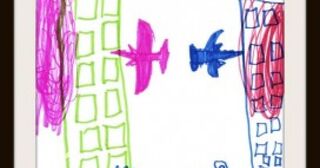Trauma
What We Learned from Children’s Drawings of 9/11
Children's drawings of 9/11 increased our understanding of psychological trauma.
Posted September 11, 2021 Reviewed by Tyler Woods
Key points
- In the aftermath of Sept. 11, 2001, children's drawings and narratives expanded our understanding of traumatic events.
- Image-making in the form of drawings stimulates storytelling significantly more than talk alone.
- Including adult "helpers" in drawings can be a sign of resilience in children impacted by trauma or loss.

Like many of you, today I am recalling many memories on this 20th anniversary of the events of Sept. 11, 2001. Some of those memories are from what I saw via televised news, others during the months after the disaster. As a trauma specialist, that day became a milestone, gradually shaping how I continue to revise my work as a psychologist and expressive arts therapist with each trauma and loss survivor during these past twenty years.
In the weeks following the terrorist attacks, I was traveling with my mentor at the time, child psychiatrist and trauma specialist Lenore Terr, MD, for lectures we had scheduled before the unexpected happened. We traveled to Chicago, San Francisco, and other large cities to groups of practitioners grateful to be able to come together to talk about "what happened" and how we might be impacted by the events that were still raw and unfiltered in body and mind.
Children's Drawings of 9/11: Expanding Our View of Traumatic Events
During those trainings, I also began my own research of sorts into how children were responding in images and narratives about 9/11. In each city we visited, I sat and listened to hundreds of school-aged children in various classrooms, recapping the events and talking about their images. These moments taught me so many things about trauma, but in particular the importance and impact of expressive approaches after a mass trauma. In retrospect, I learned several things in particular:
Image-making stimulates narrative. We now know from several research studies about why simple image-making may be important as it relates to post-traumatic events (Malchiodi, 2003; 2018; 2020). Drawing while talking about an emotionally laden event can actually stimulate two to three times as much narrative than just talking alone (Gross & Haynes, 1998). Working with children, seeing their drawings, and listening to their stories helped me to understand what Damasio (2000) discovered about the connection between "implicit stories" becoming "explicit communications," image-making (implicit communication) jump-starts the process of narrative (explicit communication). As I later wrote in 2003, expressive approaches may be useful in helping individuals reconnect "feeling with thinking.” In other words, the implicit story (the feeling of what happened) is the starting point for explicit narration.
Image-making is a form of re-exposure to sensory memories. In my interviews with children post-9/11, it became evident that drawing images or impressions of traumatic events re-exposes individuals to some of the same sensory (visual, auditory, kinesthetic, and tactile) memories of that event. For some, this is an opportunity to make meaning of an emotionally laden or upsetting experience. For others—particularly those with unresolved trauma reactions—it may trigger avoidance, intrusive memories, or anxiety, requiring strategic and sensitive intervention on the part of the therapist.
Image-making is impacted by what is experienced. The most iconic image—the twin towers being hit by planes—became the seminal depiction of 9/11 by most children. But I was surprised by one group of children who had repeatedly witnessed television footage of people jumping from the World Trade Center Towers. I was challenged to answer, "why did these people jump?" because what these children saw made no sense, understandably frightened by adults’ decisions to leap to their deaths. Takeaway: media does make a lasting impression on how we encode events.
Look for the helpers in children’s drawings. Mr. Rogers suggested that when something bad happens to us as children, it is important to look for the helpers. What I learned from those hundreds of children was simply this: if you had helpers or believed that help was coming, you were able to cope with tragedy more effectively. Children who had previous traumas and lack of caregiver support were less likely to include images of helping adults such as first responders than those children who were more resilient (Malchiodi, 2020). This observation was supported a few years later when we saw the aftermath of Hurricane Katrina. In that situation, child survivors of that disaster experienced far different circumstances than those from 9/11. Many of them did not have social support from "helping adults," surviving the hurricane and its aftermath without timely rescue and under harsh, socially stressful conditions.
I am grateful today for those moments of learning because who gets such a once-in-a-lifetime chance to be taught in such a powerful way about reparation, recovery, and restoration. That gratitude is coupled with a lingering sorrow for those who were directly impacted on this day twenty years ago. May we continue to learn from these experiences and make meaning from a day that literally changed the world.
References
Damasio, A. (1999). The feeling of what happens: Body and emotion in the making of consciousness. Fort Worth, TX, US: Harcourt College Publishers.
Malchiodi, C. (2020). Trauma and expressive arts therapy: Brain, body, and imagination in the healing process. New York: Guilford Press.
Malchiodi, C. (2014). Neurobiology, creative interventions and childhood trauma. In C. Malchiodi, (Ed.), Creative Interventions with Traumatized Children (pp. 3- 23). New York: Guilford Press.
Malchiodi, C. (2003). Art therapy and the brain. In C. Malchiodi (ed.), Handbook of Art Therapy (pp. 17-26). New York: Guilford Press


